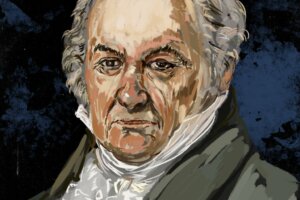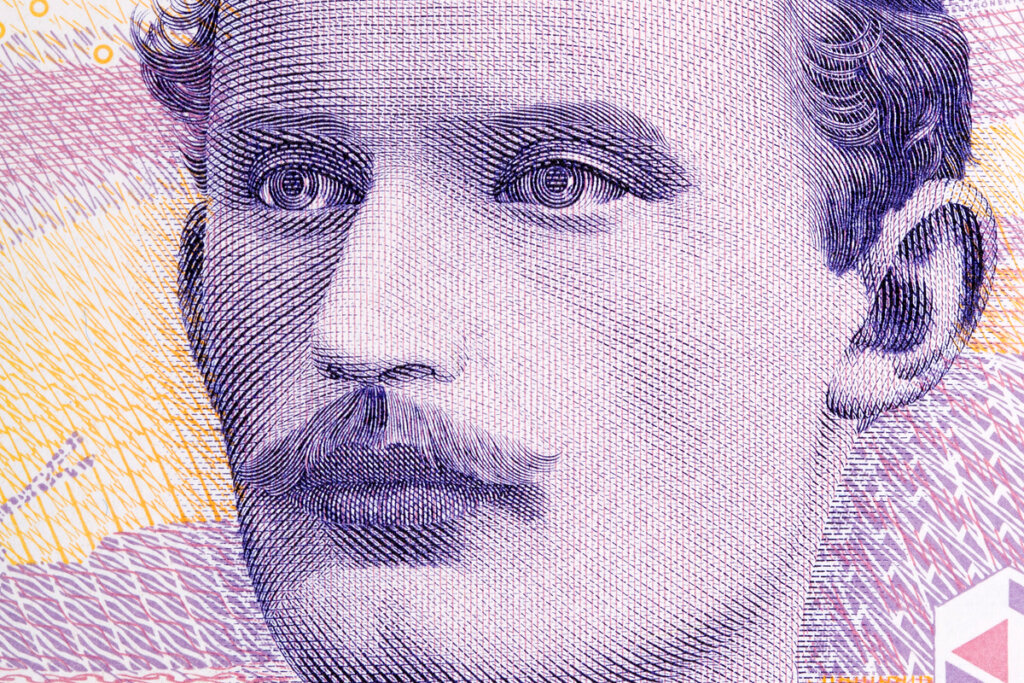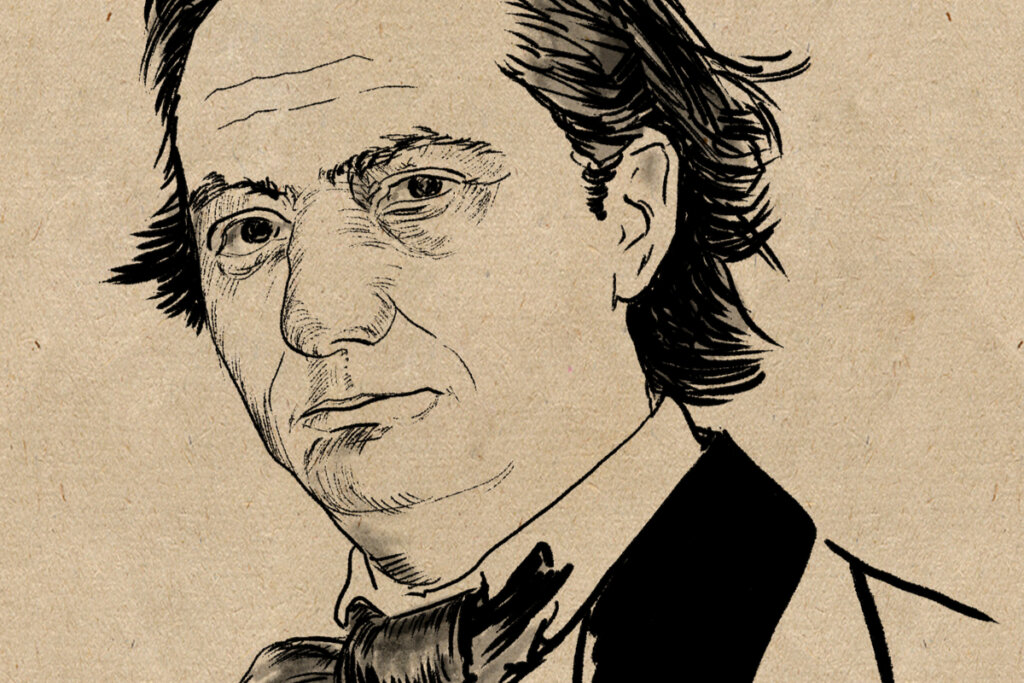Eleven of the Most Cursed Artists


Reviewed and approved by the psychologist Sergio De Dios González
Over time, some artists have been considered to be cursed. They include painters, sculptors, photographers, and writers. Would you like to know about some of them and why they’re considered to be cursed artists? If so, read the following list of 11 of them that we’ve compiled.
The adjective ‘cursed’ gained relevance in the creative field after Verlaine used it for his book The Cursed Poets (1888). Thereafter, it came to be used to refer to other established writers and artists who didn’t have an easy life.
1. Francisco José de Goya y Lucientes (1746-1828)
In 1793, Goya contracted a disease that limited him significantly. What happened?
It seems that high exposure to lead from paint was responsible, or at least a contributory factor for Goya’s deafness and alterations in behavior. Reflecting this fact, biographers have divided the course of Goya’s painting into two distinct periods. The second marks the beginning of his illness:
- The first is characterized by joy and light.
- The second, by horror and ghosts.
In fact, the painter totally changed his perception with his famous black paintings. These were gloomy works that represented human imperfection, worldly fears, cruelty, despair, and even insanity. They were created by an artist who was both deaf and ill. Furthermore, he was probably tormented by the psychological suffering caused by the combination of syphilis and lead.
2. Edvard Munch (1863-1944)
His life was extremely complicated by a disease that haunted him throughout his life.
- At just 5 years old, his mother died of tuberculosis. In fact, in The Dead Mother, you can already see the despair of the artist.
- A few years later, his sister Sophie passed away for the same reason. Hence the painting of The Sick Child.
- Unfortunately, his father met the same fate.
All these tragic events caused the painter to develop a supposed bipolar disorder. It’s reflected in the tragic expressions of the characters in his paintings.

3. Maurice Utrillo (1883-1955)
From the age of 13, the French painter Utrillo started to drink alcohol. It was the reason he dropped out of school and was probably the root cause of his attempted suicide.
We know that, months later, he was so out of control he was admitted to an asylum. According to an article published by the Museum of the Palace of Fine Arts, in 1903, his mother initiated him into painting as a form of therapy. He showed great talent in this field.
At that time, he became friends with Amedeo Modigliani and developed his so-called ‘white period’. This is recognized as the most important stage of his work and was characterized by the use of zinc white often mixed with plaster.
4. Amedeo Modigliani (1884-1920)
He was born in Livorno (Italy) and was the fourth and last child in a family of Sephardic Jews.
At the age of fourteen and recently recovered from typhoid fever, Modigliani decided to become an artist. He ended up entering the Livorno School of Fine Arts, where he was taught by Guglielmo Micheli, an Italian impressionist painter.
In 1889, Amedeo painted his first works. He was famous for his nude portraits, and characters with almond-shaped, pupilless eyes and long necks. He died at the age of 35 from tuberculosis in Paris, deeply impoverished.
5. Jules Pascin (1885-1930)
Jules possessed a restless temperament and was tormented by a permanent kind of anguish bordering on hopelessness. He was particularly interested in the human condition and was famous for his paintings of women in various stages of undress. He committed suicide at the age of 45 on the eve of a prestigious solo exhibition.
6. Chaim Soutine (1893-1943)
Soutine was the tenth child of eleven siblings. His father, a tailor by profession, didn’t approve of the boy’s fondness for art. In fact, images were forbidden within the Orthodox Jewish community.
Experts in art history claim that World War II was a severe blow to the Jewish painter. Nazi troops occupied Paris and he had to move from place to place to escape the Gestapo, often sleeping outside. Perhaps this caused the tension behind the stomach ulcer that would ultimately end his life.
Although Soutine was somewhat overshadowed by his companions, the lyrical intensity of his landscapes mixed with the violent outline of his forms and vivid colors stands out. His still lifes are particularly outstanding.
7. Zdzisław Beksiński (1929-2005)
Beksiński was a Polish painter, photographer, and sculptor. He called his creative world ‘fantastic realism’. In his work, he shaped distorted characters and images with scenes of:
- Death.
- Mutilation.
- Deformed figures.
- Skeletons
He saw no meaning in what he painted, so he didn’t give names to any of his paintings. In 1977, he moved to Warsaw, but not before burning much of his work because he considered it too personal.
Regarding his personal life, his existence was marked by the death of his wife and his only son, Tomasz, who committed suicide. In fact, it was Beksínski himself who discovered his body.
However, the tragedy didn’t end there. Indeed, in 2005, Beksínski was found dead in his home in Warsaw, brutally murdered with seventeen stab wounds to his body.
8. Charles Pierre Baudelaire (1821-1867)
Born in Paris, Baudelaire was one of the greatest exponents of symbolism. Furthermore, he’s often considered to be the initiator of modern poetry. However, he didn’t have an easy life.
- He was the son of former priest, Joseph-François Baudelaire and Caroline Dufayis. His father died in 1827 and his mother married the military man Jacques Aupick the following year.
- Baudelaire never accepted his stepfather. Therefore, family conflicts were a constant in his childhood and adolescence.
His work, Les Fleurs du Mal (The Flowers of Evil) was condemned for immorality and he received a penalty and six poems from the book were banned.

9. Paul-Marie Verlaine (1844-1896)
Verlaine was born in Metz, studied at the Lycée Bonaparte in Paris, and, soon, attracted by the reading of Baudelaire, became friends with the poets of the Parnassian group, led by Leconte de Lisle.
With his first books of poetry, Verlaine became well-known and started to exert great influence in literary circles. Nevertheless, his licentious life, alcoholism, and a stormy love affair with Rimbaud led him to jail, where he later converted to Catholicism.
In 1894 he was elected in Paris as “Prince of poets.” However, overwhelmed by his degenerate lifestyle, he died in Paris in 1896.
10. Stéphane Mallarmé (1842-1898)
Like Baudelaire, Mallarmé had an unhappy childhood. His mother died when he was five and his father remarried. His sister also died at an early age. Mallarmé also lost his only son at the age of eight.
After a trip to the United Kingdom, he married and became an English teacher at the Tournon institute. However, he soon lost interest in teaching. He subsequently became one of the highest representatives of symbolism.
“Such as unto Himself at last eternity changes him,
the poet with a naked sword provokes
his century appalled to not have known
death triumphed in that strange voice!”– “The Tomb of Edgar Poe” (1888) –
Mallarmé’s poetry is known as the most difficult to translate. This is due to its tortuous syntax, ambiguous expressions, and obscure imagery.
11. Jean Nicolas Arthur Rimbaud (1854-1891)
Rimbaud was born in Charleville, France, and began writing at a very young age. Although he was a prominent student, he dropped out of school and fled to Paris in the midst of the Franco-Prussian War to join the battle for freedom. Rimbaud was a restless soul and embarked on an affair with Verlaine that was fueled by absinthe, opium, and hashish.
Like Mallarmé, he was one of the highest representatives of symbolism. However, Rimbaud detested the vast majority of poets of his time. His literary career was short-lived and he wrote his last book at the age of twenty. He died at the age of 37 from bone cancer.
Were they cursed artists?
After reading this article, you have may have been shocked and surprised to learn about the life and works of these critically recognized artists. Indeed, it’s clear that their lives weren’t easy. However, behind the heartbreak, thanks to their literary creations they’ve all left lasting legacies.
Perhaps you’ll now be interested in delving a little deeper into their lives to discover them better and to make up your own mind as to whether they were, indeed, really cursed artists.
Over time, some artists have been considered to be cursed. They include painters, sculptors, photographers, and writers. Would you like to know about some of them and why they’re considered to be cursed artists? If so, read the following list of 11 of them that we’ve compiled.
The adjective ‘cursed’ gained relevance in the creative field after Verlaine used it for his book The Cursed Poets (1888). Thereafter, it came to be used to refer to other established writers and artists who didn’t have an easy life.
1. Francisco José de Goya y Lucientes (1746-1828)
In 1793, Goya contracted a disease that limited him significantly. What happened?
It seems that high exposure to lead from paint was responsible, or at least a contributory factor for Goya’s deafness and alterations in behavior. Reflecting this fact, biographers have divided the course of Goya’s painting into two distinct periods. The second marks the beginning of his illness:
- The first is characterized by joy and light.
- The second, by horror and ghosts.
In fact, the painter totally changed his perception with his famous black paintings. These were gloomy works that represented human imperfection, worldly fears, cruelty, despair, and even insanity. They were created by an artist who was both deaf and ill. Furthermore, he was probably tormented by the psychological suffering caused by the combination of syphilis and lead.
2. Edvard Munch (1863-1944)
His life was extremely complicated by a disease that haunted him throughout his life.
- At just 5 years old, his mother died of tuberculosis. In fact, in The Dead Mother, you can already see the despair of the artist.
- A few years later, his sister Sophie passed away for the same reason. Hence the painting of The Sick Child.
- Unfortunately, his father met the same fate.
All these tragic events caused the painter to develop a supposed bipolar disorder. It’s reflected in the tragic expressions of the characters in his paintings.

3. Maurice Utrillo (1883-1955)
From the age of 13, the French painter Utrillo started to drink alcohol. It was the reason he dropped out of school and was probably the root cause of his attempted suicide.
We know that, months later, he was so out of control he was admitted to an asylum. According to an article published by the Museum of the Palace of Fine Arts, in 1903, his mother initiated him into painting as a form of therapy. He showed great talent in this field.
At that time, he became friends with Amedeo Modigliani and developed his so-called ‘white period’. This is recognized as the most important stage of his work and was characterized by the use of zinc white often mixed with plaster.
4. Amedeo Modigliani (1884-1920)
He was born in Livorno (Italy) and was the fourth and last child in a family of Sephardic Jews.
At the age of fourteen and recently recovered from typhoid fever, Modigliani decided to become an artist. He ended up entering the Livorno School of Fine Arts, where he was taught by Guglielmo Micheli, an Italian impressionist painter.
In 1889, Amedeo painted his first works. He was famous for his nude portraits, and characters with almond-shaped, pupilless eyes and long necks. He died at the age of 35 from tuberculosis in Paris, deeply impoverished.
5. Jules Pascin (1885-1930)
Jules possessed a restless temperament and was tormented by a permanent kind of anguish bordering on hopelessness. He was particularly interested in the human condition and was famous for his paintings of women in various stages of undress. He committed suicide at the age of 45 on the eve of a prestigious solo exhibition.
6. Chaim Soutine (1893-1943)
Soutine was the tenth child of eleven siblings. His father, a tailor by profession, didn’t approve of the boy’s fondness for art. In fact, images were forbidden within the Orthodox Jewish community.
Experts in art history claim that World War II was a severe blow to the Jewish painter. Nazi troops occupied Paris and he had to move from place to place to escape the Gestapo, often sleeping outside. Perhaps this caused the tension behind the stomach ulcer that would ultimately end his life.
Although Soutine was somewhat overshadowed by his companions, the lyrical intensity of his landscapes mixed with the violent outline of his forms and vivid colors stands out. His still lifes are particularly outstanding.
7. Zdzisław Beksiński (1929-2005)
Beksiński was a Polish painter, photographer, and sculptor. He called his creative world ‘fantastic realism’. In his work, he shaped distorted characters and images with scenes of:
- Death.
- Mutilation.
- Deformed figures.
- Skeletons
He saw no meaning in what he painted, so he didn’t give names to any of his paintings. In 1977, he moved to Warsaw, but not before burning much of his work because he considered it too personal.
Regarding his personal life, his existence was marked by the death of his wife and his only son, Tomasz, who committed suicide. In fact, it was Beksínski himself who discovered his body.
However, the tragedy didn’t end there. Indeed, in 2005, Beksínski was found dead in his home in Warsaw, brutally murdered with seventeen stab wounds to his body.
8. Charles Pierre Baudelaire (1821-1867)
Born in Paris, Baudelaire was one of the greatest exponents of symbolism. Furthermore, he’s often considered to be the initiator of modern poetry. However, he didn’t have an easy life.
- He was the son of former priest, Joseph-François Baudelaire and Caroline Dufayis. His father died in 1827 and his mother married the military man Jacques Aupick the following year.
- Baudelaire never accepted his stepfather. Therefore, family conflicts were a constant in his childhood and adolescence.
His work, Les Fleurs du Mal (The Flowers of Evil) was condemned for immorality and he received a penalty and six poems from the book were banned.

9. Paul-Marie Verlaine (1844-1896)
Verlaine was born in Metz, studied at the Lycée Bonaparte in Paris, and, soon, attracted by the reading of Baudelaire, became friends with the poets of the Parnassian group, led by Leconte de Lisle.
With his first books of poetry, Verlaine became well-known and started to exert great influence in literary circles. Nevertheless, his licentious life, alcoholism, and a stormy love affair with Rimbaud led him to jail, where he later converted to Catholicism.
In 1894 he was elected in Paris as “Prince of poets.” However, overwhelmed by his degenerate lifestyle, he died in Paris in 1896.
10. Stéphane Mallarmé (1842-1898)
Like Baudelaire, Mallarmé had an unhappy childhood. His mother died when he was five and his father remarried. His sister also died at an early age. Mallarmé also lost his only son at the age of eight.
After a trip to the United Kingdom, he married and became an English teacher at the Tournon institute. However, he soon lost interest in teaching. He subsequently became one of the highest representatives of symbolism.
“Such as unto Himself at last eternity changes him,
the poet with a naked sword provokes
his century appalled to not have known
death triumphed in that strange voice!”– “The Tomb of Edgar Poe” (1888) –
Mallarmé’s poetry is known as the most difficult to translate. This is due to its tortuous syntax, ambiguous expressions, and obscure imagery.
11. Jean Nicolas Arthur Rimbaud (1854-1891)
Rimbaud was born in Charleville, France, and began writing at a very young age. Although he was a prominent student, he dropped out of school and fled to Paris in the midst of the Franco-Prussian War to join the battle for freedom. Rimbaud was a restless soul and embarked on an affair with Verlaine that was fueled by absinthe, opium, and hashish.
Like Mallarmé, he was one of the highest representatives of symbolism. However, Rimbaud detested the vast majority of poets of his time. His literary career was short-lived and he wrote his last book at the age of twenty. He died at the age of 37 from bone cancer.
Were they cursed artists?
After reading this article, you have may have been shocked and surprised to learn about the life and works of these critically recognized artists. Indeed, it’s clear that their lives weren’t easy. However, behind the heartbreak, thanks to their literary creations they’ve all left lasting legacies.
Perhaps you’ll now be interested in delving a little deeper into their lives to discover them better and to make up your own mind as to whether they were, indeed, really cursed artists.
All cited sources were thoroughly reviewed by our team to ensure their quality, reliability, currency, and validity. The bibliography of this article was considered reliable and of academic or scientific accuracy.
- Carl KH. Chaim Soutine [Internet]. London, England: E-Parkstone International; 2015 [citado 26 de octubre de 2021]. Disponible en: https://historia-arte.com/artistas/chaim-soutine
- Coquiot G. Maurice Utrillo. Newmarket, ON, Canada: Obolus Press; 2020.
- Charles Baudelaire: Mujeres malditas [Internet]. Trianarts.com. [citado 26 de octubre de 2021]. Disponible en: https://trianarts.com/charles-baudelaire-mujeres-malditas-de-las-flores-del-mal/
- Passes P. La tumba de Edgar Poe, de Stéphane Mallarmé [Internet]. Buenosairespoetry.com. 2017 [citado 26 de octubre de 2021]. Disponible en: https://buenosairespoetry.com/2017/10/31/la-tumba-de-edgar-poe-de-stephane-mallarme/
- Rogoyska J, Alexander F. Amedeo Modigliani [Internet]. Parkstone Press; 2019 [citado 26 de octubre de 2021]. Disponible en: http://museopalaciodebellasartes.gob.mx/modigliani-bio/
- Verlaine P. Los poetas malditos. NoBooks Editorial; 1991.
This text is provided for informational purposes only and does not replace consultation with a professional. If in doubt, consult your specialist.







